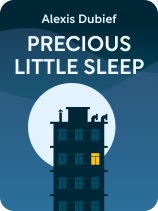

This article is an excerpt from the Shortform book guide to "Precious Little Sleep" by Alexis Dubief. Shortform has the world's best summaries and analyses of books you should be reading.
Like this article? Sign up for a free trial here.
Does your baby struggle with sleep? What does Precious Little Sleep by Alexis Dubief suggest you do about it?
Contrary to popular belief, babies don’t naturally develop healthy sleep habits on their own—they need to be taught. In Precious Little Sleep, infant sleep expert Alexis Dubief shares her strategies and guidelines for improving your baby’s sleep—from falling asleep to sleeping through the night and napping well during the day.
Read below for a brief Precious Little Sleep book overview.
Overview of Precious Little Sleep
Too often, parents accept chronic sleep deprivation as an inevitable part of raising babies and young children. However, infant sleep expert Alexis Dubief argues that enduring years of sleep deprivation is neither inevitable nor necessary. She maintains that, armed with the right knowledge and approaches, you can establish healthy sleep for your baby, which will benefit them and you. In her book Precious Little Sleep, she shares her strategies and guidelines for improving your baby’s sleep—from falling asleep to sleeping through the night and napping well during the day.
As a mother who struggled with her babies’ sleep issues, Dubief was motivated to become an expert on evidence-based infant sleep. She is a blogger-turned-author and has been sharing her knowledge with other parents as a sleep coach since 2011.
Sleep Basics
Dubief argues that contrary to popular belief, babies don’t naturally develop healthy sleep habits on their own—they need to be taught. But without proper guidance, well-intentioned strategies can lead to poor sleep patterns.
Dubief says healthy sleep is when your baby gets the right amount of sleep for their development stage, has minimal night awakenings unrelated to hunger, and has an easy, timely, and pleasant bedtime routine. She maintains that the most important way to encourage better sleep is to teach your baby to fall asleep independently. When they can fall asleep—and stay asleep—without your help, they’ll sleep well, and bedtime will be easy, short, and enjoyable.
Sleep Safety
Before we dive into Dubief’s techniques and pointers for improving your baby’s sleep, it’s important to review her sleep safety guidelines. Safe infant sleep boils down to creating and maintaining a good sleeping environment. Dubief writes that the ideal sleep environment for safe and high-quality sleep is uninteresting, dark, and free from potential causes of injury: falls, toys that present choking hazards, or anything that may accidentally strangle the child.
The most critical part of safety for children under 12 months of age is minimizing the risk factors for Sudden Infant Death Syndrome (SIDS), the leading cause of infant mortality. She recommends that you talk to your doctor about reducing the risk of SIDS. Some common recommendations include:
- Always put your baby to sleep on their back on a firm, flat surface without loose bedding or objects that could cover their face.
- Until they’re 6 months old, have your baby sleep in your room: Room-sharing may lower SIDS risk by nearly 50%. However, don’t sleep with them in your bed—studies have found co-sleeping to increase the risk of SIDS.
- Dress them lightly to avoid overheating.
- Don’t use car seats for sleeping, especially for young and premature babies.
- Don’t fall asleep with your baby on a chair or couch, or while nursing, which increases the risk of suffocation.
Forming Helpful Sleep Associations
Dubief notes that while your baby is a newborn, they’ll have unpredictable, chaotic sleep patterns and may need a lot of soothing to help them sleep. During this period, you should use every appropriate and safe technique to aid them, including rocking, bouncing, holding, massaging, and feeding.
However, Dubief says you’ll soon have to teach your newborn to sleep without your help, and to do that, you must help them form the right sleep associations—people, objects, locations, environmental conditions, or activities your baby needs to fall and stay asleep. She explains that there are two kinds of sleep associations: unsustainable and sustainable.
Unstainable associations are ones that require effort and involvement from you and that stop or disappear after your baby falls asleep—like cuddling, nursing, or bouncing your baby to sleep. When such a sleep association stops or disappears, your baby will notice, and they won’t be able to get back to sleep after one of their nightly sleep arousals.
Sustainable sleep associations are ones that remain constant from bedtime until morning and require little involvement from you—like white noise that stays on all night.
One way to help your baby learn independent sleep is to give your baby as many sustainable sleep associations as possible from the start. We’ll call these sustainable associations sleep aids. Sleep aids provide gentle assistance, and they’re relatively easy to wean from when the appropriate time comes. The ideal sleep aids are sustainable because they’re soothing, function autonomously throughout the entire sleep cycle, and do not directly involve your presence—comforting your baby while they practice falling asleep independently. The author recommends using white noise, swaddling, and pacifiers.
Sleep Aid #1: White Noise
White noise is an easy, inexpensive sleep aid that works well for most babies. White noise reduces stress by eliminating overwhelming environmental stimulation and mimicking the womb’s comforting sounds. Just make sure it’s louder than your baby’s crying so they can hear it. You can easily wean the child off white noise if and when you want to—just progressively reduce the volume of the noise for a few nights until it’s off completely.
Sleep Aid #2: Swaddling
Swaddling is one of the oldest sleep aids, and it can soothe babies to sleep from birth to around 4 months old. The author explains that by restricting startling arm movements, swaddling can reduce your baby’s night wakings and crying by up to 28%. Proper swaddling keeps the baby’s arms contained but not too tightly wrapped—you should be able to fit two fingers between the blanket and their chest. Focus just on wrapping the upper body to avoid hip issues from lower body swaddling. Don’t stress if your baby fusses initially, as the soothing benefits of swaddling usually outweigh any passing annoyance your baby might experience from the swaddling process itself.
Dubief notes that swaddling is only safe when your baby stays on their back. Swaddled babies who are put down on their bellies or roll over onto their bellies are at much higher risk of SIDS. Stop swaddling immediately if your baby shows signs of rolling over on their own, which Dubief says happens around 2 months of age on average. All babies eventually outgrow swaddling. However, the author recommends you continue swaddling until your baby can fall asleep independently, as it provides excellent support during that training process. To wean the baby off swaddling, first try it with one arm out, allowing your baby to get used to more mobility.
Sleep Aid #3: Pacifiers
According to Dubief, pacifiers can be very soothing for some babies, and they reduce the risk of SIDS during sleep. If your baby doesn’t readily take to a pacifier, experiment with different pacifier types, offer them when they’re not hungry, and use the “wiggle method” of gently tugging it once it’s in their mouth.
Some babies only need a pacifier to fall asleep initially. Others need it to stay in all night to sleep, and this sleep association is unsustainable because it requires you to reinsert the pacifier every time it pops out. If this is the case for your baby, the author recommends you wean them off the pacifier as soon as possible and use other sleep aids instead. Otherwise, she says the ideal time to phase out pacifiers is around 5 months of age—however, do this earlier if your child suffers from chronic ear infections. One method is to gently remove the pacifier once your baby falls asleep, which we’ll cover more in a later section.
Schedules and Routines
In addition to using sleep aids, you can also support your baby’s sleep by managing their sleep schedule and having the right bedtime routine.
Manage Baby’s Sleep Schedule
Dubief says that getting your baby’s schedule on track is the key to healthy sleep. It can make sleep more difficult when you put your baby down for the night too late, when they’re overtired, or too early, before they’re ready.
How do you know it’s time to put your baby down to sleep? According to Dubief, one method is to follow their tiredness cues. Tiredness cues include fussiness, eye rubbing, and yawning. However, some babies mask their fatigue until they’re overtired.
Dubief recommends you use this developmental sleep-wake chart as a guideline if following tiredness cues isn’t working:
| Infant and Toddler Sleep-Wake Chart | ||||
| Age | The Last Nap of the Day Ends | The Gap Before Bedtime | Average Bedtime | Hours of Night Sleep |
| 0-3 months | variable | 1-4 hours | Variable to late: 7:00 pm-midnight | 8-14 |
| 3-6 months | 4:00-6:00 pm | 2-3 hours | 7:00-9:00 pm | 9-13 |
| 6-9 months | 4:00 pm | 3 hours | 7:00-8:00 pm | 9-12 |
| 9-12 months | 3:00 pm | 4 hours | 7:00-8:00 pm | 10-12 |
| 1-3 years | 3:00 pm | 4-6 hours | 7:00-8:00 pm | 10-12 |
Create the Ideal Bedtime Routine
The benefits of a consistent sleep schedule are enhanced if you also have a consistent bedtime routine. The right bedtime routine can help your baby transition from alert activities to restful sleep. Form a 20- to 30-minute routine of enjoyable, quiet activities, like bathing, feeding, and reading books, and do your routine in dim lighting in the same order every night.
Independent Sleep Methods
Dubief outlines two methods for teaching your baby to sleep independently. We’ll call them the Assisted Sleep Method (ASM) and the Self-Soothe Method (SSM). She recommends you start with the more gradual ASM approach and move to SSM if needed.
Be prepared for your baby to fuss and cry as they adjust to the major change of sleeping without your help. The author asserts that it’s normal for your baby to feel frustrated and upset as they struggle to learn something new. Your baby crying during this process doesn’t make you a bad parent—your job is to support them as they learn difficult things at every stage of their lives.
According to the author, between 2 and 4 months of age is in the ideal window to begin learning to sleep independently. This is before the baby forms strong unsustainable sleep associations or hits challenging developmental milestones like teething. If you’re past that age window, no worries—simply start now. With consistency and commitment, your baby can learn how to sleep independently, which will greatly improve their sleep and yours. Once they master independent sleep, you can occasionally be flexible by offering them more soothing help during certain circumstances like illness and travel.
The Assisted Sleep Method
Dubief outlines two ASM options that will help your baby learn to fall asleep without you. ASM requires your involvement, commitment, and patience, as the process can take days to weeks.
To implement ASM, read through the options and pick one to try for at least five to seven days. If that one doesn’t work, move on to a different ASM technique. You’ll know that your independent sleep teaching is successful when your baby wakes up less frequently at night, if at all, and when putting your baby to sleep is easy, timely, and enjoyable.
Option #1: Let Baby Fuss
This option is appropriate for babies 2 months and older.
- First, deploy all your soothing methods, including sleep aids and unsustainable associations like nursing, to get your baby drowsy.
- Put your baby down in their crib, sleepy but still awake.
- Walk away, allowing them 15-20 minutes of fussing and crying before returning to soothe them again. This fussing period gives them a chance to fall asleep on their own.
- If they fall asleep on their own, congratulations—this is your new strategy.
- If they don’t fall asleep after the waiting period, you have several options. If your baby is awake but not fussing too much, wait longer and see what happens. If they’re screaming, consider waiting a few more minutes. Some babies go from screaming to sleeping without a transition. If your baby is like this, listen to your parental instinct—they might fall asleep any second, or it might be a failed experiment, which is OK. If needed, go back and soothe your baby. Try again, or wait to try for a few days.
Option #2: Progressive Weaning
Babies who need your help to fall asleep tend to favor movement and physical contact (snuggling, bouncing, and rocking) or sucking (nursing and pacifier). Each category requires a different approach to give your baby more sleep independence incrementally. You’ll gradually reduce your involvement in the soothing process over days or weeks. Progressive weaning is appropriate for babies 2 to 6 months old.
The Self-Soothe Method
SSM, also known as the “cry-it-out” method, centers on putting your child in a safe sleep environment and allowing them to learn to self-soothe. This method may be stressful for your baby as they adjust, but Dubief asserts that healthy sleep is worth a brief period of distress—SSM usually takes only a few days of consistency to teach your baby to sleep independently.
To succeed with SSM, ensure a safe sleep space, be in 100% agreement with your co-parent about the plan, and prepare to fully commit without wavering, even through distress. The author asserts that this method requires your total commitment—any inconsistency will completely undermine your efforts. If you cannot bear to hear your baby cry without going to them, hold off on SSM until you’re emotionally ready to see it through without intervention.
Troubleshoot Common Sleep Issues
Even after you successfully teach your baby to sleep independently with ASM or SSM, they may still experience some sleep issues, including waking frequently at night and waking up early in the morning (4:00 or 5:00 am).
Night Wakings: Night waking typically happens when babies either wake to feed or have remaining unsustainable sleep associations, like the pacifier. Younger babies typically need to eat during the night, while most older babies can fast longer. However, older babies who may not need to eat may still wake up if they’re in the habit of snacking at night. In these situations, you can use the same technique (ASM or SSM) you used for bedtime to wean them off unnecessary night feedings.
Early Morning Waking: If your baby wakes up too early, Dubief recommends you try using your ASM or SSM method to encourage them to return to sleep. Try this for at least a week or two before expecting consistently later wake-up times. Another trick is to give them a small “snack” feeding—this may buy you another sleep cycle without disrupting their independent sleep progress.
Dubief also suggests adjusting the baby’s bedtime to encourage them to sleep later. If the gap between your baby’s last nap and their bedtime is longer than that suggested in the sleep chart above, they may be overtired, which can cause their bodies to produce stress hormones which might lead them to awaken too early the next morning. Move their bedtime earlier by 15 minutes a day until it’s more in line with what’s typical for their age. Conversely, if your baby goes to bed very early (6:00 or 6:30 pm), they may wake early because they’ve gotten enough sleep. In this case, Dubief recommends you push their bedtime later by 15 minutes over five to seven days.
How to Improve Your Baby’s Naps
Babies who take good naps tend to sleep better at night as well. But lots of babies struggle with naps for many reasons: Nap needs change as babies grow, naps aren’t as fun as being awake, and nap schedules are delicate—illness, teething, car naps, and skipped naps can all throw things off.
Refer to this nap chart as a general guide for understanding your child’s nap needs according to age.
| Infant to Toddler Nap Chart | |||
| Age | # of Naps | Duration of Naps | Time Between Naps |
| Birth-6 weeks | 4-8 | 15 min-4 hours | 45 min-1 hour |
| 6 weeks-3 months | 3-5 | 30 min-2 hours | 1- 1.75 hours |
| 3-6 months | 3 | 1-2 hours | About 2 hours |
| 6-9 months | 3 | 1-2 hours | 2-3 hours |
| 9-12 months | 2-3 | 1-2 hours | About 3 hours |
| 12-18 months | 1-2 | 1-2 hours | 3 hours |
| 18 months-3 years | 1 | 1-2 hours | N/A |
Dubief writes that to improve your baby’s naps:
- Be consistent: Have the same nap location, pre-nap routine, and sleep aids for 80% of their naps.
- Time naps well: When naps are too early, your baby isn’t tired enough. When they’re too late, your baby becomes overtired. Use their age-appropriate wake time length and patterns as a general guide, and look for tiredness cues.
- Teach independent sleep skills: You must teach your baby how to sleep independently for naptime, just as you do for bedtime. Babies can learn to nap independently between 3 and 6 months of age.
How to Deal With Short Naps
What if you’ve taught your baby to sleep independently at night, but they only nap for 35 minutes or less? Dubief recommends you try one of the following tactics for babies 6 months and older.
- If their nap schedule is predictable, wake them up very slightly five to 10 minutes before they typically awaken. You can do this by gently nudging them until their eyes flutter. This method disrupts and resets their sleep cycle, so they fall into a deeper stage of sleep. Experiment for five to seven days.
- For the first two naps of the day, give your baby a chance to fall back asleep after waking up—leave them alone for 15 to 30 minutes. This strategy isn’t practical for the third nap (if they’re taking three) because the third nap is usually shorter than the others.
How to Help Your Baby Drop Naps
As your baby grows, they’ll take fewer and fewer naps. Navigating the transition to fewer naps can be turbulent. The author offers some tips to help.
- Shorten the nap that they’re ready to drop until they drop it completely.
- Stagger the nap that’s transitioning out to every other day for a while.
- When they drop a nap, go outside to get natural sunlight, if possible, during the time they used to nap. This helps recalibrate their circadian rhythm.
- If you have an older child who’s recently dropped their last nap, make bedtime a little earlier until they adjust.

———End of Preview———
Like what you just read? Read the rest of the world's best book summary and analysis of Alexis Dubief's "Precious Little Sleep" at Shortform.
Here's what you'll find in our full Precious Little Sleep summary:
- Techniques and pointers for improving your baby’s sleep
- Practical guidelines for infant sleep safety
- A nap chart to help you understand your child’s nap needs according to age






